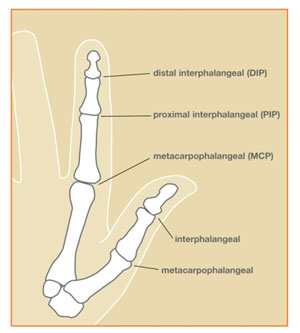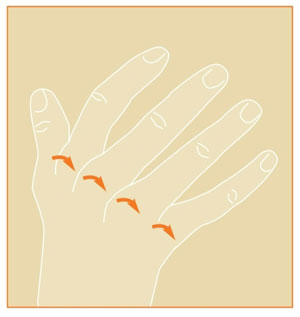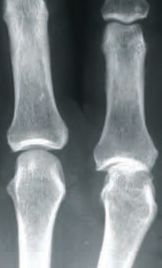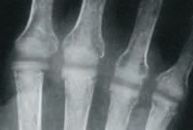The large joints in the hand at the base of each finger are known as the metacarpophalangeal (MP, or MCP) joints (see Figure 1). They act as complex hinge joints and are important for both power grip and pinch activities.
The MP joints are less often affected by arthritic conditions than the smaller joints in the hand or the joint where the thumb joins the wrist (CMC). The most common arthritic condition affecting the MP joints is rheumatoid arthritis. In this situation, the joint lining (synovium) produces chemical factors that inflame and destroy the cartilage and soft tissue, such as ligaments and tendons. The end result is that the joint surfaces are destroyed and the fingers drift into a characteristic ulnar-deviated position, in which they point towards the little finger (see Figure 2).
Less commonly, other conditions can produce pain, deformity, and motion loss. Previous injuries can result in a gradual loss of joint cartilage (post-traumatic arthritis) with progressive pain and stiffness. Similar findings are seen with osteoarthritis. Post-traumatic and osteo-arthritis most commonly affect the thumb, index, and middle fingers, and the degree of deformity is often much less severe than in rheumatoid arthrosis. Gout, psoriasis, and infection are other less common causes of MP joint arthritis.
Most patients with rheumatoid arthritis present with longstanding pain, swelling, and deformity in multiple joints of both the upper and lower extremities. They usually exhibit a characteristic ulnar drift of their fingers with loss of motion, particularly extension (straightening) of the fingers.
In cases of osteoarthritis and post-traumatic arthritis, patients usually complain of deep, aching joint pain that is worsened by grip and pinch activities. Many of these patients will not have an obvious finger deformity, although swelling, especially in the spaces between the large knuckles, is often present.
The diagnosis is usually confirmed by plain x-rays (see Figure 3). Special x-rays to look carefully at the metacarpal head are also helpful, particularly in milder cases.
Various treatment alternatives are available, based upon the degree of the joint destruction and the patient's complaints.
In cases of rheumatoid arthritis, there are a variety of medications that are very effective in combating the generalized inflammatory process. Consultation with physicians specialized in the treatment of these disorders (rheumatologists) can be very helpful. If medication fails to reduce symptoms or slow the destructive process, direct cortisone injections used judiciously can offer temporary improvement.
Similarly, in cases of post-traumatic arthritis, anti-inflammatory medication, activity modification, and simple splints can provide patients with symptom relief.
In cases of progressive pain, deformity, and motion loss despite medical management, certain patients may be candidates for surgical treatment.
Patients with rheumatoid disease at a stage without significant joint surface destruction may benefit from synovectomy, in which the active, inflamed lining tissue of the joint, the joint synovium, is removed in order to slow the destructive process and maintain joint cartilage. In addition, the soft tissues (ligaments and tendons) can be tightened and re-aligned as needed in order to improve function.
Patients with severe joint destruction may benefit from either a joint fusion or joint replacement. The thumb functions very well after an MP joint fusion. In the fingers, however, the loss of motion can be very disabling and joint replacement is usually preferred. Classically, replacement with silastic hinged implants has resulted in reasonable pain relief and function (see Figure 4). Silastic implants have been particularly successful in older, more sedentary patients with low demand on the use of their hands. More recent types of implants that try to replicate the joint surface may offer benefits to younger individuals and patients with more active, vigorous lifestyles.
Complications following joint replacement surgery include infection, implant loosening or dislocation, and implant breakage. Research is continuing to try to improve joint replacement and reconstruction in the hand.

Figure 1: Finger joints

Figure 2: Ulnar drift (fingers point towards little finger side)

Figure 3: X-ray of MP joint arthritis. The joint on the right has no space between the bones when compared to the joint on the left because of cartilage loss

Figure 4: X-rays of silastic finger joint replacements
© 2006 American Society for Surgery of the Hand





